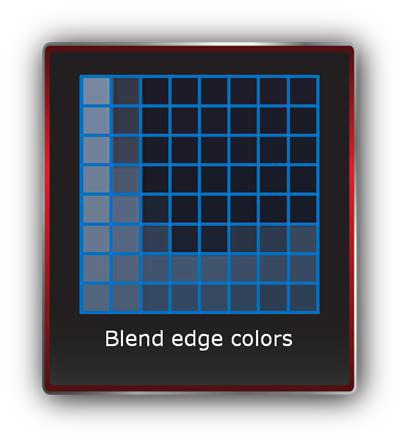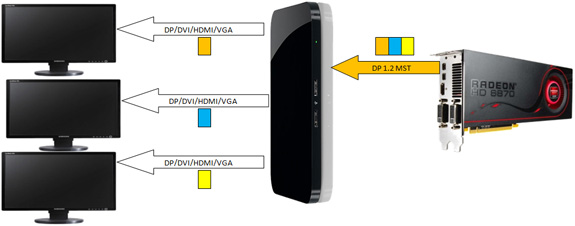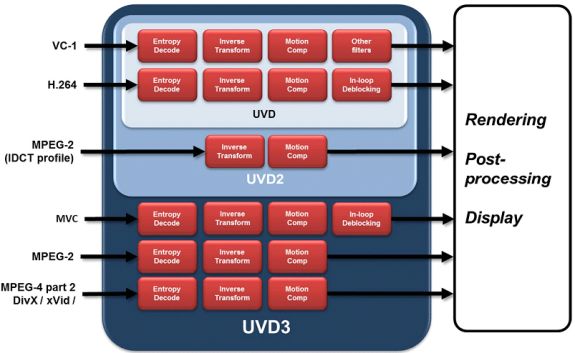AMD's Radeon HD 6970 & Radeon HD 6950: Paving The Future For AMD
by Ryan Smith on December 15, 2010 12:01 AM ESTRefresher: The 6800 Series’ New Features
Back in October AMD launched the first 6000 series cards, the Barts-based Radeon HD 6800 series. At their core they are a refreshed version of the Cypress GPU that we saw on the 5800 series, but AMD used the opportunity to make some enhancements over the standard Cypress. All of these enhancements apply throughout the 6000 series, so this includes the 6900 series. As such for those of you who didn’t pay much attention to the 6800 series, we’re going to quickly recap what’s new in order to lay the groundwork for further comparisons of the 6900 series to the 5800 series.
We’ll start with the core architecture. Compared to Cypress, Barts is nearly identical save 1 difference: the tessellator. For Barts AMD implemented what they call their 7th generation tessellator, which focused on delivering improved tessellation performance at lower tessellation factors that AMD felt were more important. Cayman takes this one step further and implements AMD’s 8th generation tessellator, which as the naming conventions implies is the 7th generation tessellator with even further enhancements (particularly those necessary for load balancing).
The second change we saw with Barts and the 6800 series was AMD’s refined texture filtering engine. AMD’s texture filtering engine from the 5800 set new standards by offering angle independent filtering, but it had an annoying quirk with highly regular/noisy textures where it didn’t do a good enough job blending together various mipmaps, resulting in visible transitions between them. For the 6800 series AMD fixed this, and it can now properly blend together noisy textures. At the same time in a controversial move AMD tweaked its default filtering optimizations for the 5800 series and entire 6000 series, leading to these cards producing imagines subtly different (and depending on who you ask, subtly worse) than they were on the 5800 series prior to the Catalyst 10.10 drivers.

| Radeon HD 5870 | Radeon HD 6870 | GeForce GTX 480 |
The third change we saw was the introduction of a new anti-aliasing mode, initially launched on the 6800 series and backported to the 5800 series shortly thereafter. Morphological Anti-Aliasing (MLAA) is a post-processing filter that works on any (and all) images, looking for high contrast edges (jaggies) and blending them to reduce the contrast. Implemented as a compute shader, it works with all games. As it’s a post-processing filter the results can vary – the filter has no knowledge of depth, polygons, or other attributes of the rendered world beyond the final image – so it’s prone to blending everything that looks like aliasing. On the plus side it’s cheap to use as it was originally designed for consoles with their limited resources, so by not consuming large amounts of memory & memory bandwidth like SSAA/MSAA it usually has a low performance hit.


Last but not least, AMD made a number of changes to their display hardware. The Universal Video Decoder (UVD) was upgraded to version 3, bringing full decode support for MPEG-2, MPEG-4 ASP, and H.264 MVC (packed frame video for 3D movies). For the 6900 series this is not of great importance as MPEG-2 and MPEG-4 ASP are low complexity codecs, but it does play an important role for AMD’s future APU products and low-end GPUs, where offloading these low complexity codecs is still going to be a big relief for the slower CPUs they’re paired with. And on that note the first public version of the DivX codec with support for UVD3 will be shipping today, letting 6800/6900 series owners finally take advantage of this functionality.
The second of the major display changes was the addition of support for the DisplayPort 1.2 standard. DP1.2 doubles DisplayPort’s bandwidth to 21.6Gbps, finally giving DisplayPort a significant bandwidth lead over dual-link DVI. With double the bandwidth it’s now possible to drive multiple monitors off of a single root DisplayPort, a technology called Multi Stream Transport (MST). AMD is heavily banking on this technology, as the additional bandwidth coupled with the fact that DisplayPort doesn’t require a clock source for each monitor/stream means AMD can drive up to 6 monitors off of a single card using only a pair of mini-DP ports. AMD is so cutting edge here that like the 6800 series the 6900 series is technically only DP1.2 ready – there won’t be any other devices available for compliance testing until 2011.

Finally, the 6800 series also introduced support for HDMI 1.4a and support for color correction in linear space. HDMI 1.4a support is fairly straightforward: the 6000 series can drive 3D televisions in either the 1080p24 or 720p60 3D modes. Meanwhile support for color correction in linear space allows AMD to offer accurate color correction for wide gamut monitors; previously there was a loss of accuracy as color correction had to be applied in the gamma color space, which is only meant for use for display purposes. This is particularly important for integrating wide gamut monitors in to traditional gamut workflows, as sRGB is misinterpreted on a wide gamut monitor without color correction.
While all of these features were introduced on the 6800 series, they’re fundamental parts of the entire 6000 series, meaning they’re part of the 6900 series too. This provides us with a baseline set of improvements over AMD’s 5800 series, on top of the additional improvements Cayman and AMD’s VLIW4 architecture brings.











168 Comments
View All Comments
henrikfm - Wednesday, December 15, 2010 - link
The right numbers for these cards considering the performance:6970 -> 5875
6950 -> 5855
flyck - Wednesday, December 15, 2010 - link
Anand also tested with 'outdated' drivers. It is ofcourse AMD fault to not supply the best drivers available at launch though. But anand used 10.10, Reviews that use 10.11 like HardOcp see that the 6950 performance equally or better than 570GTx!! and 6970 trades blows with 580GTX but is overall little slower (but faster than 570GTX).And now we have to wait for the 10.12 drivers which were meant to be for 69xx series.
flyck - Wednesday, December 15, 2010 - link
my bad anand tested with 10.11 :shame:10.12 don't seam to improve performance.
That said, Anand would it be possible to change your graphs?
Starting with the low quality and ending with the high quality? And also make the high quality chart for single cards only. Now it just isn't readable with SLI and crossfire numbers through it.
According to your results 6970 is > 570 and 6950~570 but only when everything turned on.. but one cannot deduct that with the current presentation.
Will Robinson - Wednesday, December 15, 2010 - link
$740 for HD6970 CrossfireX dominates GTX580 SLI costing over $1000.That's some serious ownage right there.
Good pricing on these new cards and solid numbers for power/heat and noise.
Seems like a good new series of cards from AMD.
prdola0 - Wednesday, December 15, 2010 - link
No, you're wrong. Re-read the graphs. GTX580 SLI wins most of the time.softdrinkviking - Wednesday, December 15, 2010 - link
By a small average amount, and for ~$250 extra.Once you get to that level, you're not really hurting for performance anyway, so for people who really just want to play games and aren't interested in having the "fastest card" just to have it, the 6970 is the best value.
Nfarce - Wednesday, December 15, 2010 - link
True. However AMD has just about always been about value over an all out direct card horsepower war with Nvidia. Some people are willing to spend for bragging rights.But I'm a little suspect on AT's figures with these cards. Two other tech sites (Toms Hardware and Guru3D) show the GTX 570 and 580 solidly beating the 6950 and 6970 respectively in the same games with similar PC builds.
IceDread - Friday, December 17, 2010 - link
You are wrong. HD 5970 in crossfire wins over gtx 580 sli. But anandtech did not test that.ypsylon - Wednesday, December 15, 2010 - link
A lot of people were anxious to see what AMD will bring to the market with 6950/6970. And once again not much. Some minor advantages (like 5FPS in handul of games) is nothing worth writing or screaming about. For now GTX580 is more expensive, but now with AMD unveiling new cards nVidia will get really serious about the price. That $500 price point won't live for long. I expecting at least 50$ off that in the next 4-6 weeks.GTX580 is best option today for someone who is interested in new VGA, if you do own right now 5850/5870/5970 (CF or not) don't even bother with 69[whatever].
duploxxx - Wednesday, December 15, 2010 - link
at that price point a 580 the best buy, get lost. The 580 is way over prized for the small performance increase it has above 570-6970 not to mentioning the additional power consumption. Don't see any reason at all to buy that card.Indeed no need to upgrade from a 58xx series but neither would be to move to a nv based card.